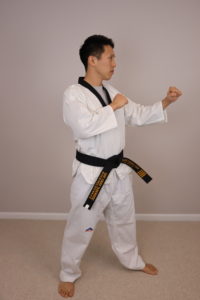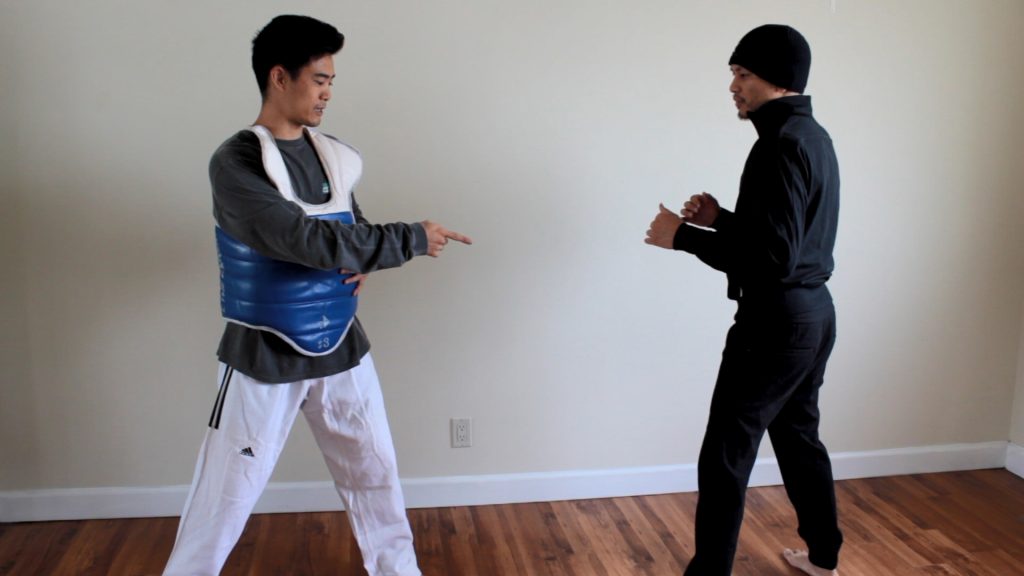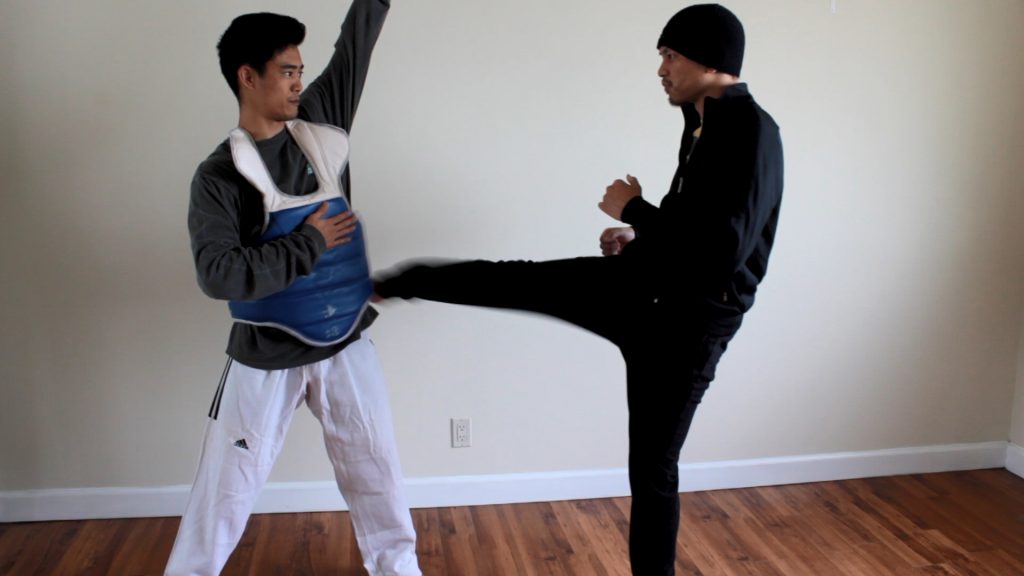There’s really only two, Open or Closed. Taekwondo has a collection of different stances similar to many other Martial Arts, but most are not practical for sparring.

Traditional vs. Practical
Nearly every Martial Art shares similar stances; Horse Stance, Back Stance, Forward Stance, Cat Stance, Praying Mantis! All of them help to develop and fine-tune your leg muscles. Each stance has its own practical application to certain moves that are structured within the style. However, most of them are not suitable for competition sparring.
Karate Kid introduced the world to the illustrious Crane Stance and the elusive Front Kick to the Face. Fortunately, I have never witnessed anyone try this at a Taekwondo competition, but I wouldn’t be surprised if this technique had been attempted during a match. If my opponent stood on one leg with his hands up to his side like little wings, I’ll probably gawk at him before sidestepping for a better shot.
Most combat sports refer to Orthodox and Southpaw Stances. Personally, I think these terms are irrelevant to Taekwondo. For a fighter to choose between Orthodox or Southpaw is dependent on their preferred side; Right-handed, or Left-handed. Indeed, a Taekwondo competitor will have a preference on which leg to kick with, but elite competitors are well-versed with both.
Fighting Stance

The purpose of a fighting stance is to have your body ready for offense or defense. Each combat sport has their own preferred stance to allow the fighter optimal flexibility between attacking, blocking, and moving. Kickboxers prefer to stand tall, feet close together and hands up front, with no regard to defend takedowns. Wrestlers stand low with their feet wide apart to be able to shoot downwards for their opponent’s leg, or defend themselves from it.
For its intent and purpose, the best fighting stance for Taekwondo sparring is a hybrid of the Front Stance and Walking Stance. Standing tall like a kickboxer provides better mobility, but decreases your kicking range. A wider stance gives stability for stronger kicks, but diminishes mobility. Therefore, a stance between those two would be in your favor.
Start from the position of attention. Take a step forward with your preferred Lead Leg at a length of about two shoulder widths apart. From there, on the ball of your feet, turn your feet opposite of the leg you stepped forward with at about 30 to 45 degrees. This turn should also turn your hips a little bit. Bend your knees slightly to “spring-load” your legs. It helps to lift the heel of the rear leg to keep it at the ready.
When referring to Taekwondo Sparring, the fighting stance is how you are positioned in relations to your opponent.
Open Stance

When the opponent is in the opposite stance as you, it is the Open Stance. It’s kind of like looking at a mirror. Whatever you throw at them, if they were to do the same, it’ll come from the other direction. The swing of their attack should be countered in the same direction. For example, if your opponent attacks with a rear leg Roundhouse, it should be countered with a Back Kick. Or, if he attacks with a lead leg Roundhouse, that can be countered with a rear leg Roundhouse.
Many knockouts have occurred from the Open Stance because it offers a better position for spinning counter attacks. Hence, to move in with a rear leg Roundhouse in this stance is dangerous. I recommend utilizing your lead leg to apply pressure and defend with the Cut Kick. Rear leg Roundhouse should be executed when the opponent is in between beats, or if you are confident of your speed.
Closed Stance

Orthodox vs. Orthodox. Southpaw vs. Southpaw. This is the fighting stance where you have to make an opportunity for a strong counter. You are in fair grounds with your opponent where an attack can be countered with the same thing. In the Closed Stance, you’ll have to get a little creative with your tactics.
A rear leg Axe Kick could be useful, which your opponent can counter with a rear leg Roundhouse to the chest or head, that is, if he is able to block or dodge your attack. A Cut Kick feint can bait a lead leg counter, which you can exploit with a Back Kick. A high lead leg Hook Kick can be unexpected, for it is not often used. Continuously assess your opponent to see how he reacts to your offense.
Stance Determines Which Tools Are Available
Tactics must change between Open and Closed Stances due to physical limitations. In Open Stance, you’d have to reach with your rear leg Roundhouse, while in the Closed Stance, you have to be wary of striking the spine, for it is an illegal move and the ref will dish out kyongos.
Open Side and Closed Side
Each stance has an “open” side and a “closed” side available for attack. Basically, the Open side is where the chest guard is facing, while the Closed side is the nearest available side to strike.
Let’s take a look at these when in the Open Stance.
First, the Open Side at Open Stance…


Now, the Closed Side at Open Stance…


Let’s take a look at these in the Closed Stance.
First, the Open Side at Closed Stance…


Now, the Closed Side of Closed Stance…


Practice sparring with a partner in both stances. Pay attention to Body Mechanics to see what moves are effective. Working with pads and targets are great for conditioning, but those do not show you how a human moves and reacts to your arsenal. To prepare for sparring, nothing will beat practicing sparring with a real person.
